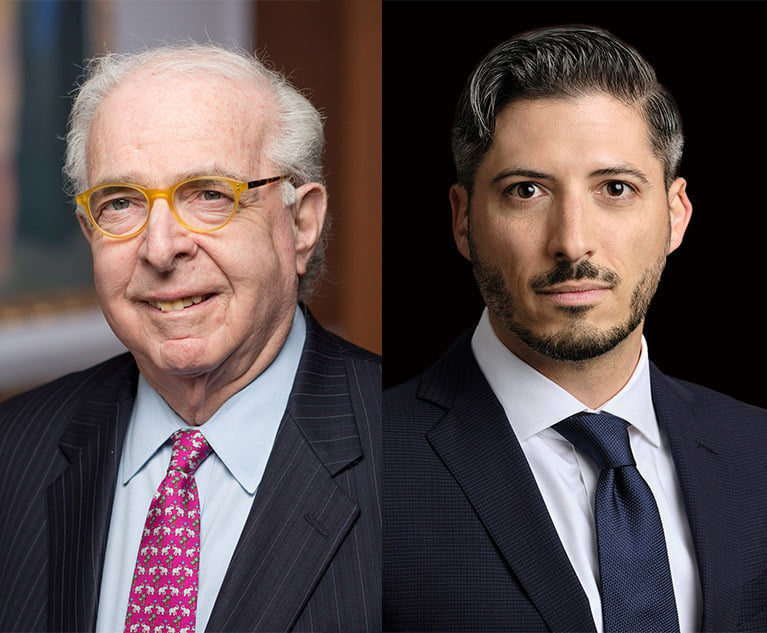Employment Arbitration: A Practical Assessment of Advantages and Disadvantages
Michael Weber writes: As the U.S. Supreme Court again revisits issues related to employment arbitration agreements in a series of cases involving class and collective action waivers, we revisit the advantages and disadvantages of implementing a workplace arbitration program.
November 27, 2017 at 12:00 PM
9 minute read
 For years, employers of all sizes have implemented arbitration programs as a means of resolving employment disputes. (In an article that appeared in the New York Law Journal on Jan. 12, 2017, we made practical suggestions for how to draft enforceable arbitration agreements that are likely to withstand court scrutiny. See A. Michael Weber, “Mandatory Arbitration Agreements: To Be or Not to Be,” 257 N.Y.L.J. 4 (Jan. 12, 2017).) During that same time period, the U.S. Supreme Court has repeatedly held that the Federal Arbitration Act mandates enforcement of Arbitration Agreements in all but the most unusual circumstances. See generally DIRECTV v. Imburgia, 136 S. Ct. 463 (2015); AT&T Mobility v. Concepcion, 563 U.S. 333 (2011); Circuit City Stores v. Adams, 532 U.S. 105 (2001); Gilmer v. Interstate Johnson v. Adams, 500 U.S. 20 (1991).
For years, employers of all sizes have implemented arbitration programs as a means of resolving employment disputes. (In an article that appeared in the New York Law Journal on Jan. 12, 2017, we made practical suggestions for how to draft enforceable arbitration agreements that are likely to withstand court scrutiny. See A. Michael Weber, “Mandatory Arbitration Agreements: To Be or Not to Be,” 257 N.Y.L.J. 4 (Jan. 12, 2017).) During that same time period, the U.S. Supreme Court has repeatedly held that the Federal Arbitration Act mandates enforcement of Arbitration Agreements in all but the most unusual circumstances. See generally DIRECTV v. Imburgia, 136 S. Ct. 463 (2015); AT&T Mobility v. Concepcion, 563 U.S. 333 (2011); Circuit City Stores v. Adams, 532 U.S. 105 (2001); Gilmer v. Interstate Johnson v. Adams, 500 U.S. 20 (1991).
Now, as the U.S. Supreme Court again revisits issues related to employment arbitration agreements in a series of cases involving class and collective action waivers, we revisit the advantages and disadvantages of implementing a workplace arbitration program.
The State of the Law
As recently as December 2015, the U.S. Supreme Court reiterated the well-accepted principle that “federal policy favor[s] arbitration,” and arbitration agreements should be placed “on equal footing with all other contracts.” Imburgia, 136 S. Ct. at 468, 471 (internal citations and marks omitted). This principle is reflected in §2 of the Federal Arbitration Act, which provides, in mandatory terms, that arbitration agreements “shall be valid, irrevocable, and enforceable.” 9 U.S.C. §2.
On Oct. 2, 2017, the Supreme Court heard oral argument in three consolidated cases which address the issue of whether arbitration agreements containing a class and collective action waiver are enforceable under the Federal Arbitration Act, notwithstanding provisions of the National Labor Relations and the Norris LaGuardia Acts, which guarantee employees the “right” to engage in “concerted activities.” Epic Systems v. Lewis, Docket No. 16-285 (U.S. 2017); Ernst & Young v. Morris, Docket No. 16-300 (U.S. 300); NLRB v. Murphy Oil USA, Docket No. 16-307 (U.S. 207). It is widely expected that the court will reaffirm its commitment to the enforceability of arbitration agreements, and uphold the collective and class action waivers that many employers include in arbitration agreements.
Practical Advantages of Employment Arbitration
There are a number of important reasons why an employer might choose to implement an arbitration program in the workplace. In many single-plaintiff cases, arbitration is less costly than a jury trial. Costs associated with extended jury trials, including time spent preparing and participating in voir dire, drafting and responding to motions in limine, quarreling over proposed jury instructions, and creating jury-ready demonstrative exhibits, do not exist in arbitration. Further, unlike juries who may feel sympathetic to a plaintiff or antagonistic to large employer and award large sums including excessive punitive damages, arbitrators may be less inclined to allow personal biases or emotions to affect their award. Indeed, arbitration awards consistently are smaller than jury awards in similar state and federal court litigation. In the class and collective action context, assuming the Supreme Court rules as we expect them to rule, the savings could be far larger. A class and collective action wavier in an arbitration agreement eliminates the significant litigation and settlement costs associated with defending class actions, which allow a single employee to bring suit on behalf of many.
The lack of a potential runaway jury or a large class also has the advantage of reducing settlement values. In mediations and settlement discussions, plaintiffs' attorneys are unable to leverage the looming threat of unpredictable juries potentially susceptible to an emotional plaintiff's appeal. Plaintiffs' attorneys also lose the ability to leverage a potential class or collective action motion or the potential that a class or collective action notice will be distributed to hundreds of employees or posted in the workplace.
Generally, arbitration also is faster than traditional litigation. A comprehensive study of nearly 4,000 arbitration cases found that arbitration cases which settled lasted an average of 284.4 days, and arbitration cases decided after hearing lasted an average 361.5 days; a substantially shorter time period than most state and federal court employment litigations. See Alexander Colvin, “An Empirical Study of Employment Arbitration Case Outcomes and Processes,” 8 J. Empirical Legal Studies 1 (March 2011).
Finally, arbitration can protect an employer from unwanted publicity. Courts are inherently public forums. With few exceptions, docket filings are made available for any and all to view and trials are conducted with an open door to the public. Some employers may have reasonable concerns about litigating internal workplace disputes in a public trial. By contrast, arbitrations involve private filings and closed hearings. Internal disputes are unlikely to become external exhibitions by media-savvy plaintiffs' lawyers.
Practical Disadvantages of Employment Arbitration
Notwithstanding these clear advantages, however, disadvantages also exist, which employers should consider. Although arbitrations generally are cheaper than jury trials, arbitration costs have begun to escalate. Generally, employers agree in arbitration agreements to pay both the employer's and the employee's shares of the arbitrator's expenses and fees, including initial filing fees and hourly billing rates. This is, in part, because several courts have invalidated arbitration agreements that imposed a cost- or fee-splitting requirement on the ground that the cost- or fee-splitting made access to arbitration impracticable, and thus, substantively unconscionable. See, e.g., Greentree Fin. Cop.-Ala. v. Randolph, 531 U.S. 79 (2000); Brady v. Williams Capital Grp., 14 N.Y.3d 459 (2010); Cole v. Burns Sec. Servs., 105 F.3d 1465 (D.C. Cir. 1997). (An exception exists when the employee is highly paid. In such a scenario, courts may permit the parties to split the costs of arbitration. Lubowiecki v. Ernst & Young U.S., No. A-0577-04T1, 2005 WL 3309785, at *1 (N.J. Super. Ct. App. Div. Dec. 8, 2005); Arakawa v. Japan Network Grp., 56 F. Supp. 2d 349, 355 (S.D.N.Y. 1999).) Therefore, unlike traditional litigation, arbitration may impose significant additional fees and costs. Further, in addition to the arbitrator's expenses and fees, employers are responsible for their own attorney fees and costs. Added together, these costs can be significant. Indeed, the “case management fees,” “hearing time fees”, and “post-hearing retainer” charged by some large arbitration providers could exceed $40,000. These fees are in addition to an employer's own attorney fees and costs. By contrast, state and federal judges do not charge the parties hourly rates for their time presiding over a hearing or drafting a decision.
There also may be increased costs associated with moving to compel arbitration of employment disputes which are covered by an arbitration agreement, and defending against employee challenges to the enforceability of an arbitration agreement. Although a carefully-worded arbitration agreement can reduce these costs, they may not be eliminated.
Additionally, unlike traditional litigation, the scope of appellate review of an arbitration determination is narrow. Under the Federal Arbitration Act, an arbitrator's award may be vacated only where some corruption, fraud, undue means, evident partiality, misconduct or excess of power infected the process. See 9 U.S.C. §10(a). Similarly, limited review is available under the CPLR. See N.Y. C.P.L.R. §7511. Unlike traditional litigation, an arbitrator's mistake of law is not a ground for vacating the arbitration award. See Hall St. Assocs. v. Mattel, 552 U.S. 576 (2008); Maross Constr. v. Cent. N.Y. Reg'l Transp. Auth., 66 N.Y.2d 341, 346 (1985).
Furthermore, some arbitrators are far less likely than courts to grant dispositive motions. (This potential disadvantage, however, can be mitigated in a well-drafted arbitration agreement, which should expressly allow the arbitrator to accept dispositive motions.) Summary judgment in employment matters is now a widely accepted method of disposing of cases in which there are no genuine issues of material fact. See Venezia v. Luxottica Retail N. Am., No. 15-3451, 2017 WL 4772437 (2d Cir. Oct. 23, 2017); Lawson v. Homenuk, No. 16-3736-CV, 2017 WL 4534779 (2d Cir. Oct. 11, 2017); Forte v. Liquidnet, 675 F. App'x 21 (2d Cir. 2017). Further, under the Supreme Court's holdings in Bell Atlantic v. Twombly, 550 U.S. 554 (2007) and Ashcroft v. Iqbal, 556 U.S. 662 (2009), federal courts may dismiss complaints that fail to state plausible claims for relief at the pleadings stage.
Fundamentally, courts have an interest eliminating cases that lack merit from their docket. The same incentive does not exist for arbitrations. In fact, contrary incentives exist. Arbitrators are paid an hourly or a daily rate. Although one might hope it is not a driving motivation, financial considerations may play some role in an arbitrator's reluctance to consider or grant a dispositive motion.
The manner in which arbitrators are selected may play a role in an arbitrator's refusal to consider or grant dispositive motions. Often, arbitrators are jointly selected by the parties from a panel of potential arbitrators. Each party submits his, her, or its rankings of the potential arbitrators, and a consensus arbitrator based on those rankings is assigned. Arbitrators who develop a reputation for having a proclivity for one side, or who are known to grant dispositive motions are unlikely to be highly ranked, and therefore, unlikely to be selected.
The Takeaway
Considerations of whether to adopt or keep an employment arbitration program must be made based on individualized employer circumstances after careful consideration of the advantages and disadvantages. Employers who opt to implement an arbitration program should draft an arbitration agreement that maximizes the advantages while minimizing, to the extent feasible, the disadvantages. A middle ground between arbitration and traditional litigation may also exist. For example, companies may consider a jury wavier to obtain the benefits of traditional litigation, while minimizing the uncertainties created by a jury trial.
Michael Weber is a shareholder at Littler Mendelson in New York. Shawn Matthew Clark, an associate at the firm, assisted in the preparation of this article.
This content has been archived. It is available through our partners, LexisNexis® and Bloomberg Law.
To view this content, please continue to their sites.
Not a Lexis Subscriber?
Subscribe Now
Not a Bloomberg Law Subscriber?
Subscribe Now
NOT FOR REPRINT
© 2025 ALM Global, LLC, All Rights Reserved. Request academic re-use from www.copyright.com. All other uses, submit a request to [email protected]. For more information visit Asset & Logo Licensing.
You Might Like
View All
Art of the Settlement: Trump Attorney Reveals Strategy in ABC Lawsuit

Evolving Legal Standards to Combat Disqualification of Arbitrators for Failing to Disclose Conflicts of Interest
8 minute read
Court of Appeals Holds that Arbitration Agreements Can Be Formed Through ‘Clickwrap’ Process
8 minute read
Trending Stories
Who Got The Work
J. Brugh Lower of Gibbons has entered an appearance for industrial equipment supplier Devco Corporation in a pending trademark infringement lawsuit. The suit, accusing the defendant of selling knock-off Graco products, was filed Dec. 18 in New Jersey District Court by Rivkin Radler on behalf of Graco Inc. and Graco Minnesota. The case, assigned to U.S. District Judge Zahid N. Quraishi, is 3:24-cv-11294, Graco Inc. et al v. Devco Corporation.
Who Got The Work
Rebecca Maller-Stein and Kent A. Yalowitz of Arnold & Porter Kaye Scholer have entered their appearances for Hanaco Venture Capital and its executives, Lior Prosor and David Frankel, in a pending securities lawsuit. The action, filed on Dec. 24 in New York Southern District Court by Zell, Aron & Co. on behalf of Goldeneye Advisors, accuses the defendants of negligently and fraudulently managing the plaintiff's $1 million investment. The case, assigned to U.S. District Judge Vernon S. Broderick, is 1:24-cv-09918, Goldeneye Advisors, LLC v. Hanaco Venture Capital, Ltd. et al.
Who Got The Work
Attorneys from A&O Shearman has stepped in as defense counsel for Toronto-Dominion Bank and other defendants in a pending securities class action. The suit, filed Dec. 11 in New York Southern District Court by Bleichmar Fonti & Auld, accuses the defendants of concealing the bank's 'pervasive' deficiencies in regards to its compliance with the Bank Secrecy Act and the quality of its anti-money laundering controls. The case, assigned to U.S. District Judge Arun Subramanian, is 1:24-cv-09445, Gonzalez v. The Toronto-Dominion Bank et al.
Who Got The Work
Crown Castle International, a Pennsylvania company providing shared communications infrastructure, has turned to Luke D. Wolf of Gordon Rees Scully Mansukhani to fend off a pending breach-of-contract lawsuit. The court action, filed Nov. 25 in Michigan Eastern District Court by Hooper Hathaway PC on behalf of The Town Residences LLC, accuses Crown Castle of failing to transfer approximately $30,000 in utility payments from T-Mobile in breach of a roof-top lease and assignment agreement. The case, assigned to U.S. District Judge Susan K. Declercq, is 2:24-cv-13131, The Town Residences LLC v. T-Mobile US, Inc. et al.
Who Got The Work
Wilfred P. Coronato and Daniel M. Schwartz of McCarter & English have stepped in as defense counsel to Electrolux Home Products Inc. in a pending product liability lawsuit. The court action, filed Nov. 26 in New York Eastern District Court by Poulos Lopiccolo PC and Nagel Rice LLP on behalf of David Stern, alleges that the defendant's refrigerators’ drawers and shelving repeatedly break and fall apart within months after purchase. The case, assigned to U.S. District Judge Joan M. Azrack, is 2:24-cv-08204, Stern v. Electrolux Home Products, Inc.
Featured Firms
Law Offices of Gary Martin Hays & Associates, P.C.
(470) 294-1674
Law Offices of Mark E. Salomone
(857) 444-6468
Smith & Hassler
(713) 739-1250






